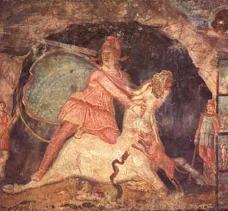The Mithraeum
The Mithraeum is a sanctuary consecrated to the Indo-European god Mithra, whose cult expanded rapidly in the 1st-century Roman Empire, particularly popular among Roman soldiers.
During the works for the railway station, in 1962 was discovered this sanctuary located within a cistern, as the impermeable layer of plaster on its walls (cocciopesto) testifies.
The plant is typical of a Mitreo: behind a wide entrance hall (thirteen meter long and eight meter wide), there is a long e narrow tunnel (twenty-nine meter-long and three meter wide; it's the longest
Mithraeum of the Roman Empire) where, along the walls there were some benches ("podia", where the disciples of this cult laid down during the celebrations and the common meal).
The vault, three meter high, it has not been decorated as in some other sanctuaries where were a starry sky.
The wall on the bottom is decorated with a polychrome fresco (2nd century AD) representing the best archaeological evidence of the god's worship: the scene called the tauroctony where the god Mithra is cutting the throat of a bull, a sacrificial rite that aims to regenerate the world.
From the tail of the animal appear some ears of corn, while a dog and a snake drink its blood and a scorpion stings its testicles.
The god is dressed with a red tunic, a pair of red pants, a blue mantle on his shoulder symbolising the sky.
In upper part of the fresco there are the sun and the moon, while in the lower part there are two men holding torches: Cautes, with the torch up and Cautopates, with the torch down. Four little frescoed scenes on each side of this fresco represent the other events of the Mithra's myth.
In the centre of the nave and before the representation of Mithras on the back wall is an altar with the inscription "INVICTO DEO CRESCES ACTOR ALFI SEBERI D P ".
Surroundings
-
The Sacro Speco

An impressive complex of buildings which almost looks as if it is one with the surrounding rock...
To know more
-
Rocca Pia
Built on the place where Callisto II Borgia's Castle was situated...
-
Church of St.Peter
It was built on the rests of a roman villa...
Tivoli's attractions

Patrocinio Comune di Tivoli
Assessorato al Turismo



